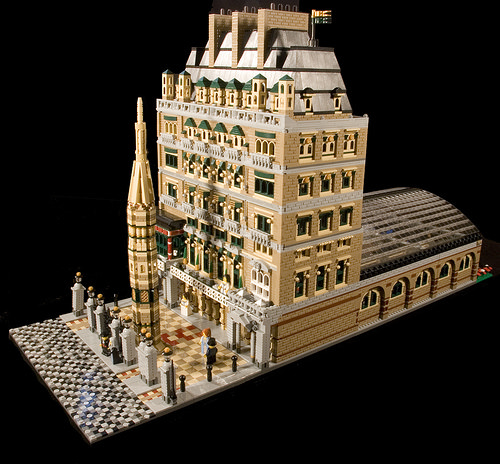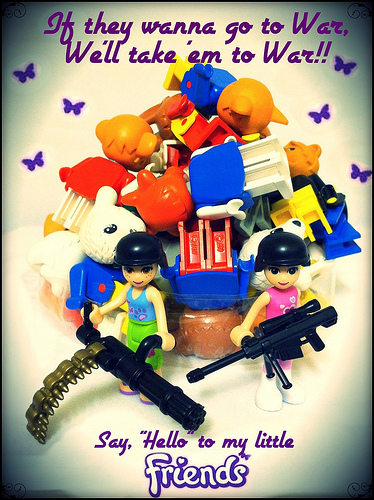
Ever since I saw the preliminary photos from last year’s New York Toy Fair, I knew I was going to buy this set and do a review for the blog. I also immediately knew that this set had to be the work of Mark Stafford. I asked Mark if he would be willing to answer a few questions for me to include in the review. Not only did he graciously agree to do so, but he also gave me some exclusive development photos (see below).
So first the review and then I will get to the interview:
One word for this set, FUN. Whether you are a 32 year old man-kinder like myself, or a 6 year old LEGO maniac like my oldest son, chances are you are going to love this set. I am not even going to get into a lot of details in terms of price per part ratios, collectibility of the minifigs etc. Instead I am just going to say, “Buy this set!”
The build itself is rather brilliant, with a lot of clever techniques for achieving a robust mecha of a satisfying girth. There is also a great selection of parts in fresh colours like dark azure, and a whole shwack of brackets, which I seem to always be running out of. But in all honesty, I am going to find it hard to take this thing apart to steal bricks, it is simply too much fun to play with (as evidenced by the video below).
http://www.flickr.com/photos/tromas/9927563856/
So long story short boys and girls; I highly recommend this set whether you want something to play with, or you want a good selection of highly useful parts. And don’t even get me started on how awesome the new Gorilla tribe weapons are!
Now on to the interview (& the exclusive design pics!):

TBB: What was your initial inspiration for this set? Apart from the obvious
gorilla influence, I must admit that the first thing that came to mind upon
seeing the images of the set was the Iron Mecha Challenge that you were a
part of in the Mecha Hub flickr group a couple years back, did that have any
impact on the design?
Mark Stafford: Wow, yeah, the Iron Mecha 2 challenge was a bit weird, at that point we were already into early Chima development and myself and Jordan Schwartz had made ourselves stop building ‘FabuForce’ MOCs because it was too similar an idea. But I had promised to source the inspiration picture for Iron Mecha and LEGO Designer Luis Castenda had told me he had a Mecha image from his portfolio I could use. I got it from him at the last minute – and it was Gorilla inspired! I almost called the whole thing off, but figured that would be even more suspicious, so we went ahead with it. I built almost exactly what was in Luis’s picture, no real exploration of Gorilla’s or anything too far from the original image as I knew that this might come up soon at work! Sure enough, though Gorilla’s were not in the first launch I was asked to make a Mecha for the summer releases and I still had a ton of ideas I hadn’t used ready to try out!
TBB: How and when did the Chima cartoon factor into the design process of these
sets (if at all)? Because when I saw those gorilla mechs in the final
battle scene, I thought you may have been behind them, so it came as no
surprise when I found out that you were the designer of this set.
Mark Stafford: We need to send images of the main vehicles through very early in the process, pictures are taken of our sketch models on a gridded background for the animation company to start building 3D interpretations of, and from that point on no matter how many pieces change on the model its overall shape and dimensions should remain roughly the same. Once the TV guys have started work it’s very time consuming for them to change things. There was only one major change with the Gorilla Striker in that the original sketch had a glass cockpit, but this was just too far from the look we had established for the rest of Chima and of course this meant a modification of the TV model needed to be made.
TBB: I recall you telling a story about how you and the others designers of the
Ninjago line would toss around ideas for character names (some rather
hilarious ones resulted if I remember correctly). I am picturing a similar
situation for the development of the banana cannon, any funny story behind
that, or is it simply a creative stroke of Stafford genius?
Mark Stafford: Oh yes, the one eyed snake I wasn’t allowed to call ‘Trowza’… though that was nothing compared to the two hour giggle fest meeting because every single suggestion for the names of Power Miners vehicles sounding like an innuendo!
I can’t remember who first suggested the banana cannon for Chima but once it was an idea there was no way it was not going to be on this model whoever got to build it! Plus I knew from Power Miners that bananas work for kids; I included a banana in the Crystal Sweeper set after a kids test where we couldn’t find a prototype dynamite element and I threw in a banana instead, the kids played for an hour with the rock monsters stealing it and the miners having to get it back. Something about a banana in a set triggered a lot of imagination. This Striker has seven! In an ammo belt! Genius? Far from it, but definitely fun to play with!
TBB: The new weapon elements for the Gorilla Tribe minifigs look quite amazing.
Were you directly behind or involved in the design in any way? I ask this
because these elements seem like they were designed with the intention of
them being highly useful in alternate builds as opposed to being strictly
minifig weaponry.
Mark Stafford: The part designer for both the Gorilla fist and the Hammer elements was Gabriel Sas, like all of our new elements they have to fit into the LEGO system. The entire Chima team had brainstormed weapon ideas, coming up with a Gorilla Hammer and power fists. Then later we get to give input into the parts and we made some suggestions for what would be nice to include, but time is tight with these parts and I think there are a couple of things I would change to make them even more usable as building elements if I had the chance now. That’s always the way though, and they are still very nice and they are going to be hugely useful for details and for microscale builders or minifigure character makers!
TBB: How many prototypes did you go through for this set, and was there any feature from
your initial prototype that you had to sacrifice that you wished you could
have included in the final design?

Mark Stafford: There were about five serious redesign loops on this mecha – and that’s not counting the sketch models some other designers did before I started. There’s this one by Maarten Simons which was the first built with the banana cannon idea included and this grey futuristic one is by Soren Dryhoj and I stole ideas from both for my version. One of the things I hated dropping was the Chi-crystal being in the chest instead of on the chest flap, but I just couldn’t find a way to have it that way around without the door knocking it out of place every time it was closed. I also kind of wish the final version had a closed cockpit over the pilot, but I guess it would look like he had a transparent skull!
TBB: As a LEGO set designer, we know that you have to work within design
constraints in terms of balancing pieces, price and playability. What part
of this design did you find the most challenging in that regard?
Mark Stafford: It was the Raven’s lookout post. It grew and shrank constantly throughout the design process as expense came and went from the Gorilla Striker. The final version is not the largest that it got to, but it’s far from the smallest, and I think it gives plenty of play value – and a few extra cool new parts/colour changes too.
TBB: Over the years you have designed a lot of fantastic sets. How does this
one stack up to you personally in terms of your own favourites?
Mark Stafford: This has a few touches I’m pretty proud of, the locking of the body around the arm sockets and the way everything fits in around and through each other in the torso for example, and I’m really happy with the beefiness of this one, I don’t think I can make a heavier two legged mecha either, or at least not without fully locking the legs. I’m also happy to get more Dark Azure out there, I really like this colour!
TBB: This set certainly has the largest amount of dark azure parts out
of all the Chima line, did you include this colour because you feel guilty
about killing teal? (sorry, couldn’t resist throwing a teal question in
there ;)
Mark Stafford: You can explain how I killed teal (*), (it was a colour I really liked, that’s why it hurt so much) but yes, the two new Azure blues are in a similar part of the colour wheel and I like them both a lot, particularly Dark Azure, so I’ll use them whenever I get the chance, if it makes sense for the model. I don’t feel guilty about teal though – after all I saved purple!
*Mark’s first set as a LEGO designer, was the Exo-Force Dark Panther. He had the choice of making it in either purple or teal, and whichever colour he chose, the other would be cut from the colour palette. Obviously he chose purple. Hence, Mark Stafford Killed Teal.
TBB: Thanks again!
Mark Stafford: No problem.
Buy @ Amazon.ca
The Brothers Brick is funded by our readers and the community. Articles may include affiliate links, and when you purchase products from those links, TBB may earn a commission that helps support the site.














